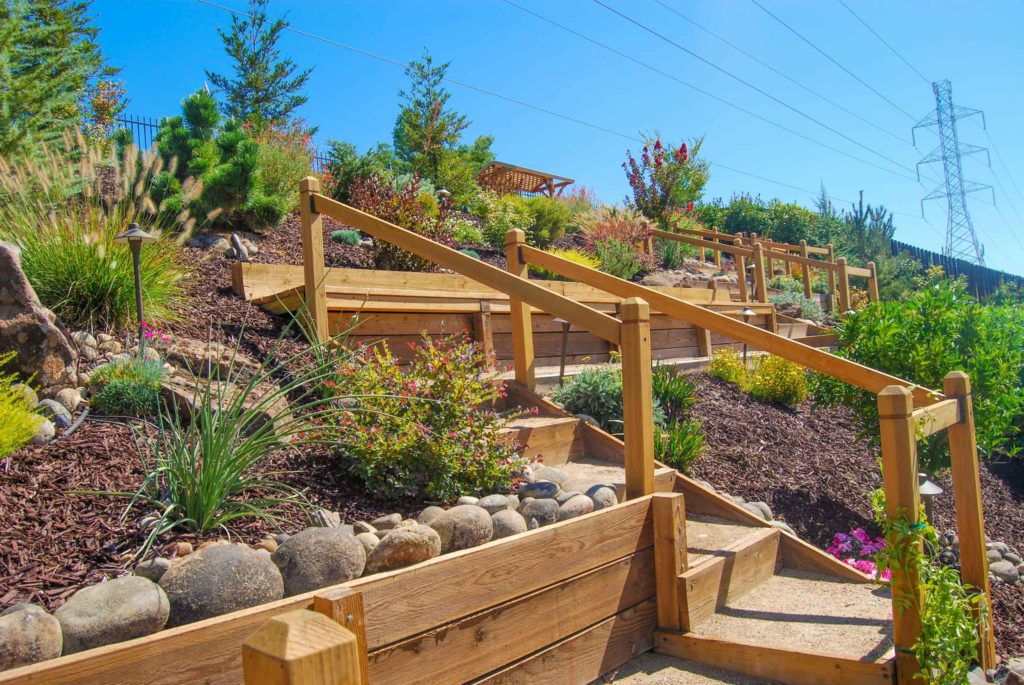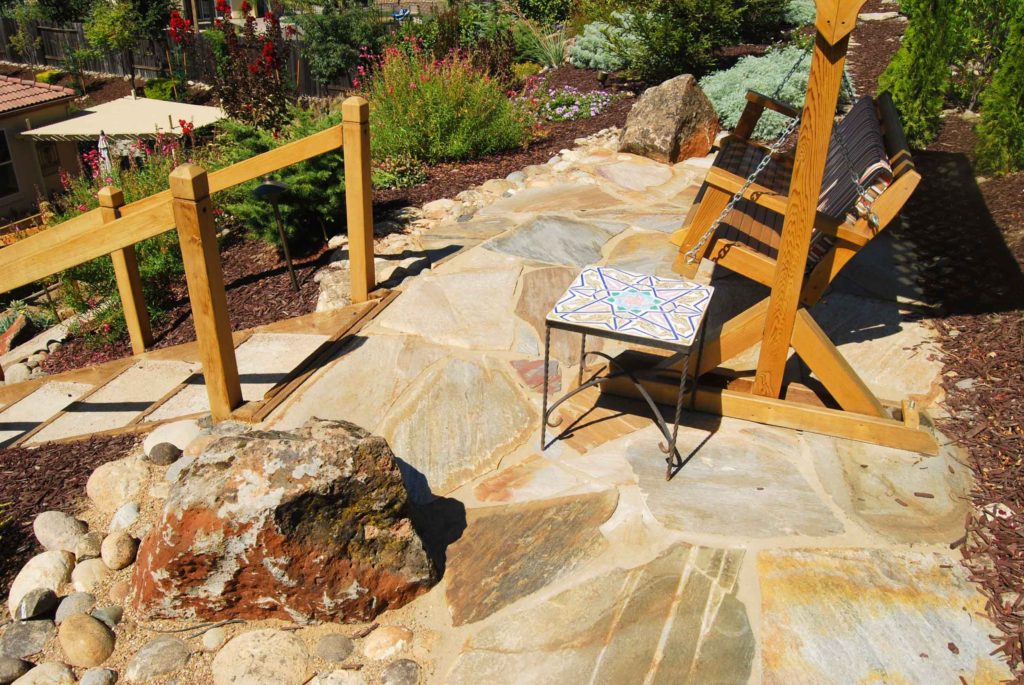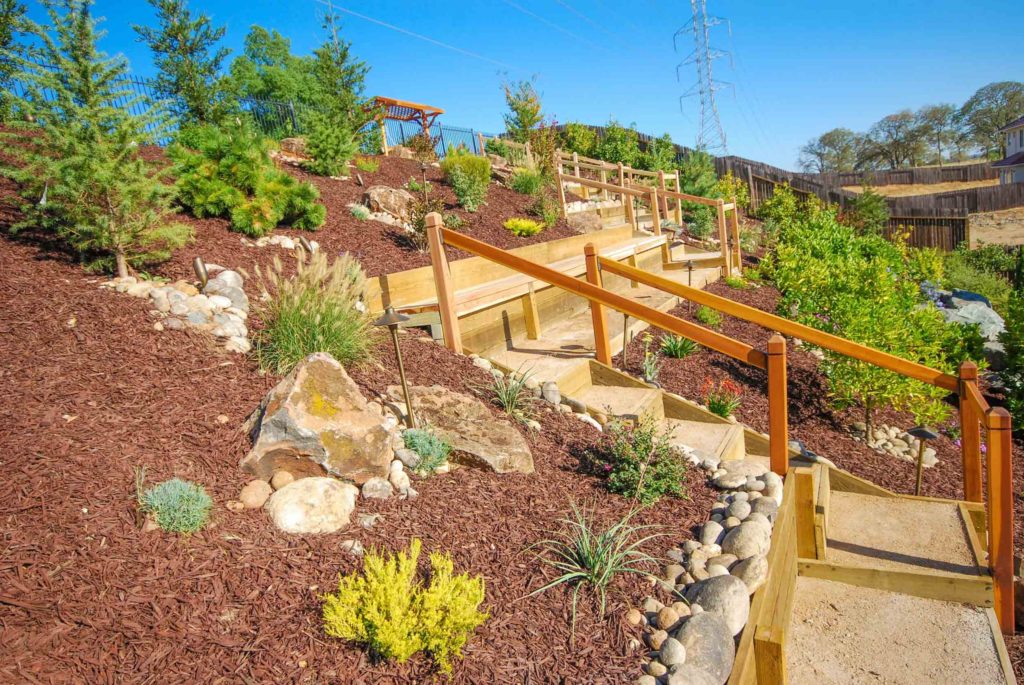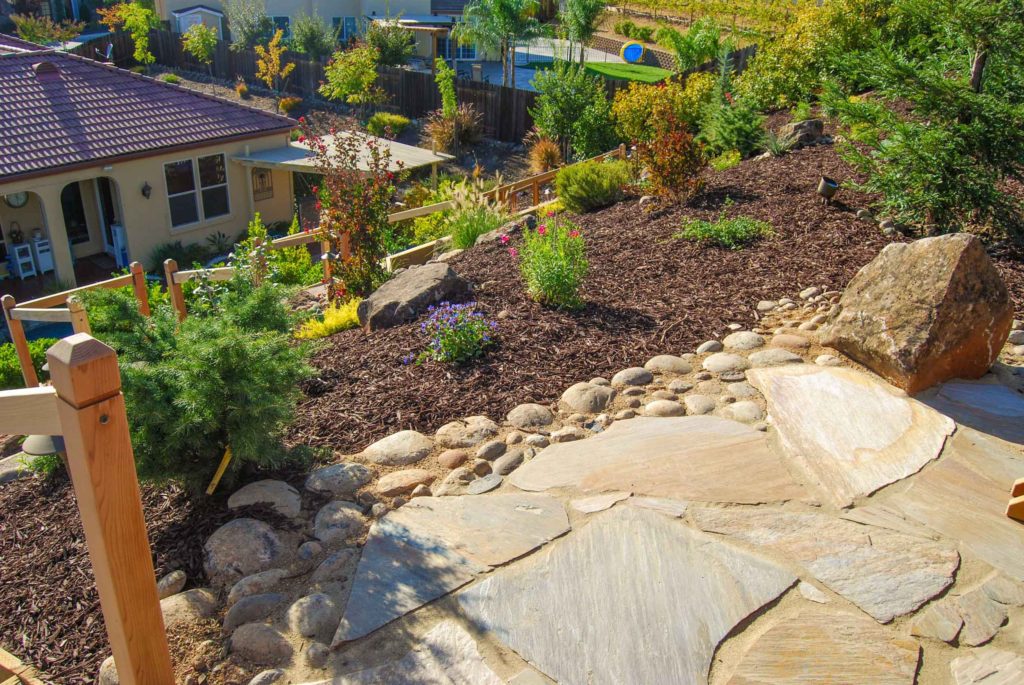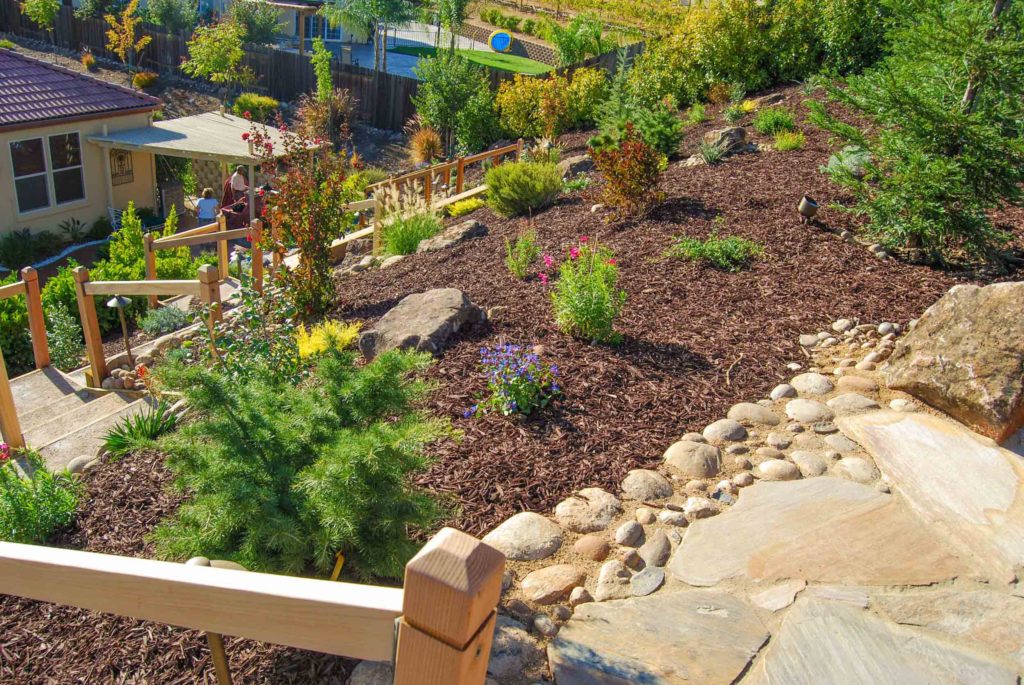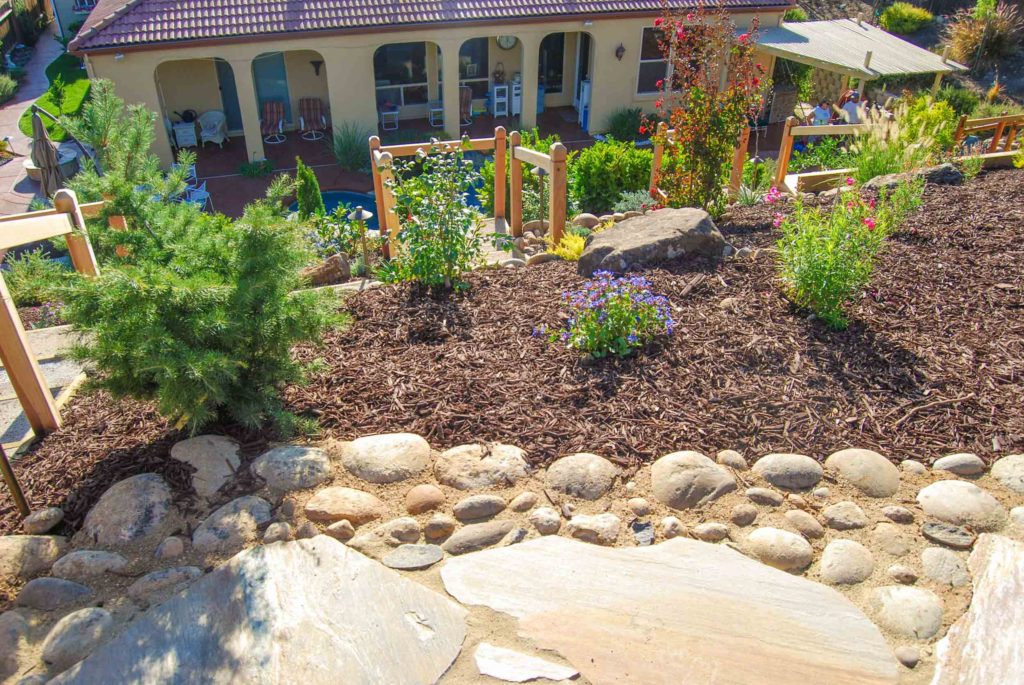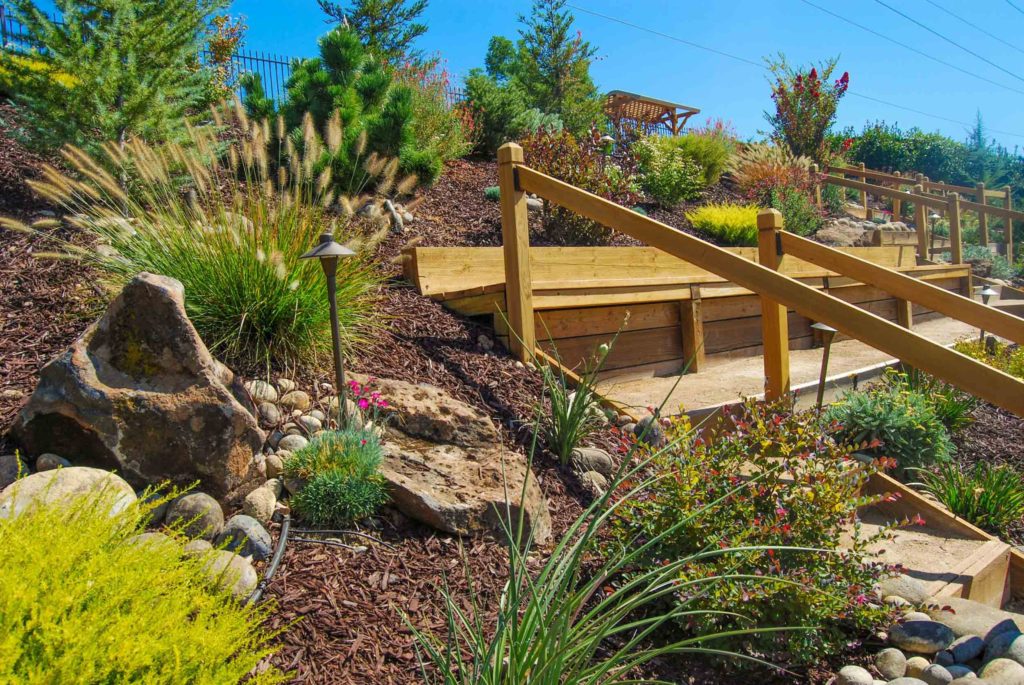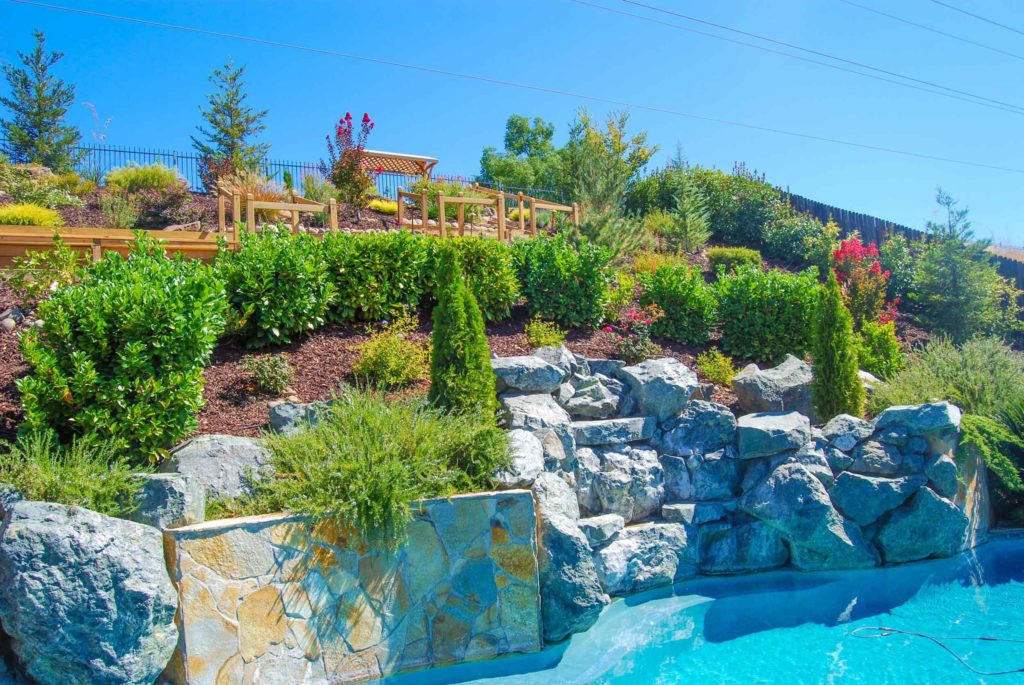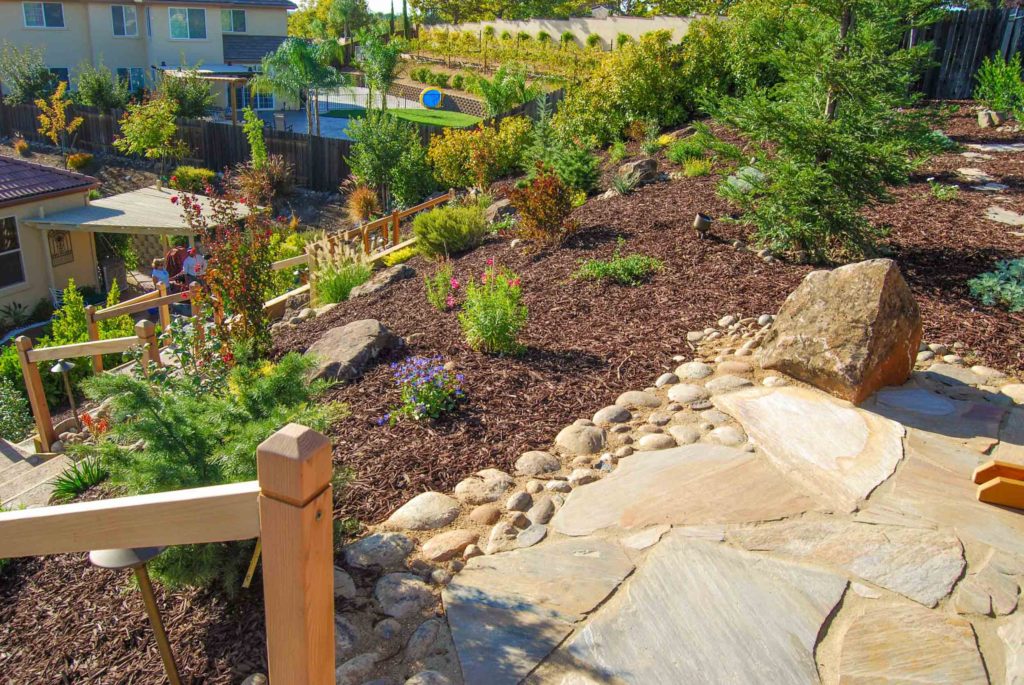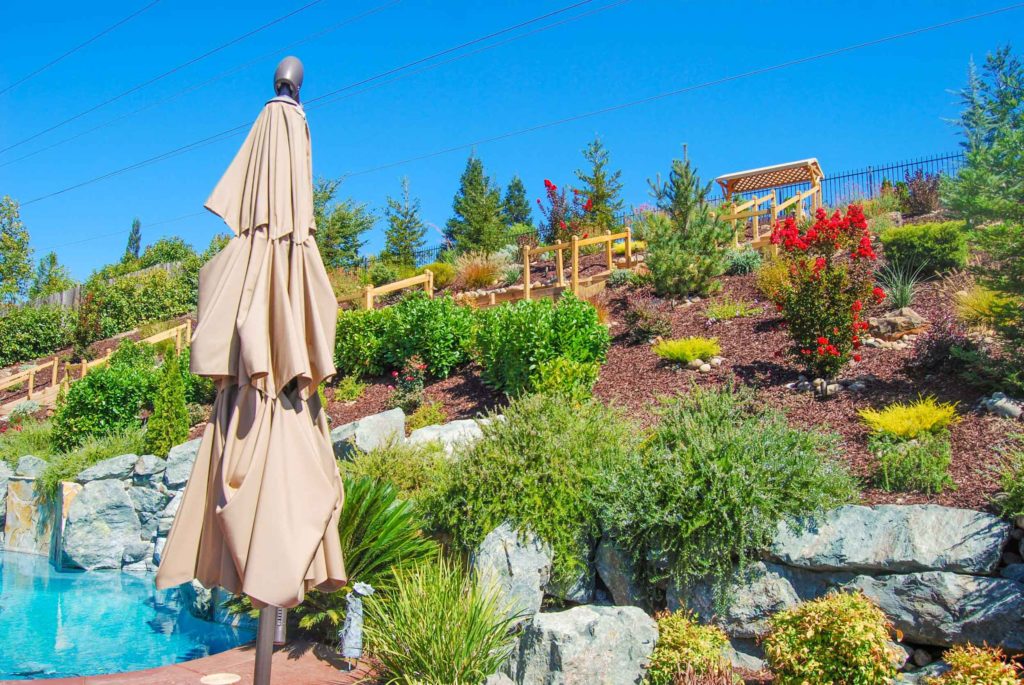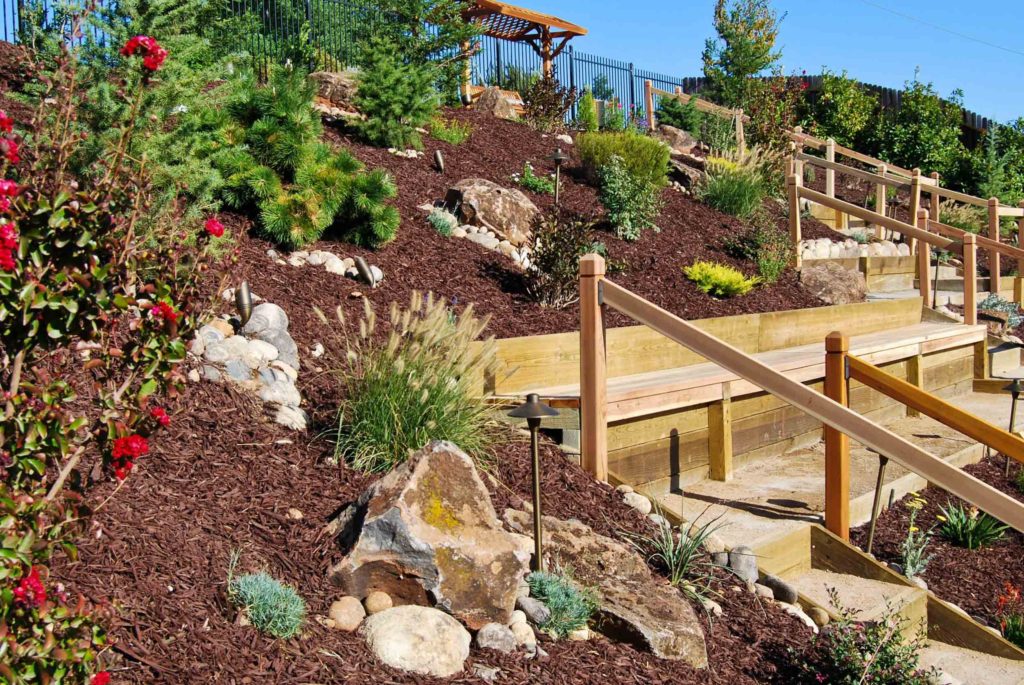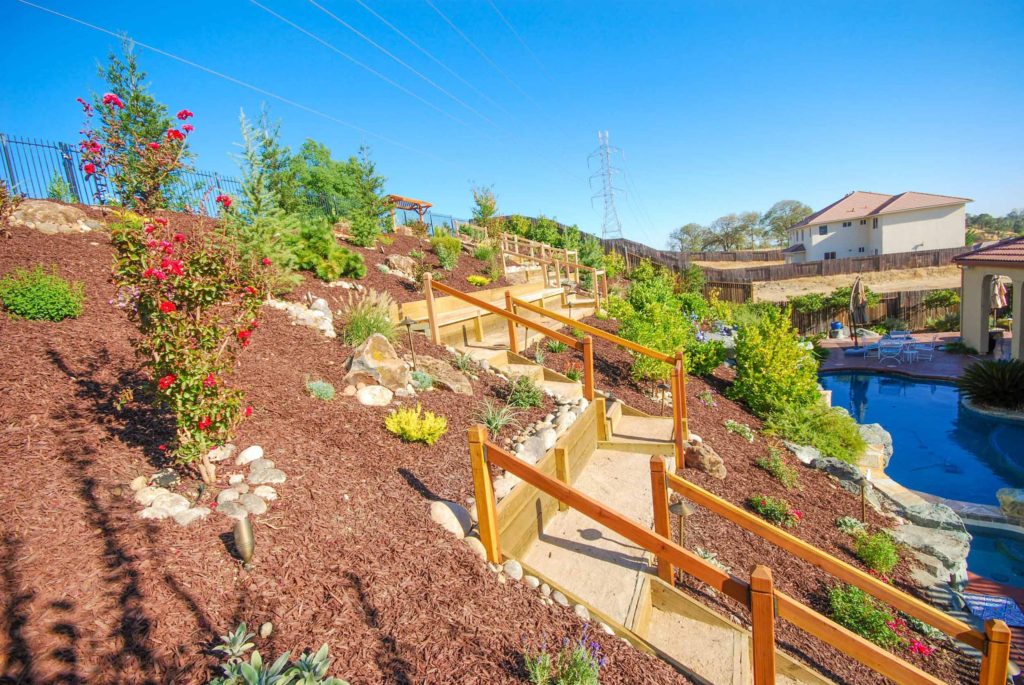Growing Roots
I trust everyone had a nice holiday. Christmas and Thanksgiving are two of the few holidays that families make the effort to get together. It truly can be a special time. We will not be attending
the Cal Expo Home and Garden Show this year and the main down- side is I really enjoy talking to you! However, I look forward to meeting many of you via our appointments. Our business comes from you via the magazine, not so much the show. So, as much as w will miss that we are already getting busy, so if you are thinking of landscaping please make an appointment soon. We have a self-registering website and it will take you to the days available (Janu- ary is full). For those of you who took the time to call or email me regard- ing the Christmas article, thank you.

Your words were very encouraging; they mean a lot to me (it is the first time I shared my struggles publicly). Each January I like to start the New Year off by reviewing landscape care, hence the title. As a grower in the wholesale business that I come from, my focus was on growing strong roots. If I succeeded in that, the plant would do the rest and grow strong and healthy shoots. I want to discuss the care of the garden, and directly connected to that is your enjoy- ment of it. Although I will be speaking in “big picture” terms, you can find more detailed information by clicking on the tab titled, “Landscape Tips,” on our website (www.executivecareinc.com). It makes no sense to spend money on a landscape and not have some understanding of the garden. Plant care can be broken down into
three general categories: Proper Irrigation, Pruning, and Fertilization. Generally speaking, if we are hitting high marks in these three areas, the plant can fend off the bugs and protect itself.
Proper Irrigation Trees are often the most neglected in the land- scape. We tend to not water the trees deep enough, therefore compromising their health, and causing many other concerns. Surface roots are a result of this causing difficulty in mowing, and concern that the roots will crack a driveway or sidewalks. Aphids, weak growth and yellow leaves are also the result of improper watering. Ultimately, the tree can become top heavy and potentially fall over due to the lack of deep rooting. If you have this problem, it is best to seek the advice of an arborist. Next, check your drip emitters and make sure you have two per plant and at least two gallon per hour for landscapes 3 years or older. For trees, I prefer 3 drip bubblers evenly spaced around the dripline of the tree. An extra measure would be to include tree wells. You can assist the downward flow of water with an 8” long and 4” wide PVC pipe. It must be back filled with gravel and have a drip bubbler inside. This enables the water to soak into the ground as opposed to running off. Lastly, remember to check the emitters and bubblers from time to time. Emitters can get clogged and bubblers need adjusting on occasion. Minimum run times for drip is 35 minutes, 45 minutes for landscapes 4 years and older – 4 to 5 days a week during the growing period. If you sink when you walk on your lawn, it is time to dethatch. Dethatching “beats up the lawn” as it removes the dead lawn matter that interferes with irrigation and fertilization. To find out how deep the thatch is, cut a wedge-shaped piece with the shovel and then lift it leaving the back side intact. Measure the distance from where the soil ends to where the blades of grass emerge. That will give you a good indication of how thoroughly you need to thatch the lawn. More than 3⁄4 inch of thatch starts costing more money in irrigation and fertilizer use. Aeration is also recommended, especially for lawns on slopes. Remember to check your sprinklers for leaks, plugged nozzles or buried heads. If the lawn is on a slope and you are using conventional nozzles you may want to consider the water miser nozzles (MP Rotor nozzles), though I also recommend them for level lawns. See your irrigation stores for more information on this. They minimize run-off and allow the water to soak into the lawn better. The alternative is to water less but use multiple cycles with conventional nozzles.

Pruning Plants: In proper combinations they bring so much beauty to the landscape. Unfortunately, most of the landscapes we do are “re-dos.” They consist of the same eight to ten plants. These plants tend to be aggressive growers, which need frequent pruning. During the next few months these large growers can be pruned up to fifty percent. This will make them more manageable. In hard pruning there is one rule. Never leave the plant without leaves. Prune the top first or the sides, but not both. Let the pruned portion leaf out and then do the other. Trees: Just keep them thinned; with our strong winter winds, the canopy acts like a sail and catches the wind. Evergreen trees such as Magnolias, Japanese Pears and especially African Sumacs are examples of trees that can topple over. Oak trees are by far the worst, leaves or no leaves. Be diligent to keep these under the care of an arborist, especially if they are growing close to your home.
Fertilization Even if you are not pruning, fertilizer should be applied. My preference is an organic fertilizer with mycorrhizae (fungi). These beneficial fungi help the plants with nutrient up- take and drought tolerance. The organic fertilizer feeds the biology in the soil, which in turn feeds the plants. This is nature’s way. Nurseries and some irrigation stores are now carrying organics. Be generous with the fertilizer as if you are heavily salting your food. Once you have broadcasted the fertilizer, scratch it into the ground if possible. I know with mulch and roots this step is not do-able. In either case the rains will help carry the fertilizer and fungi down to the roots. And since this is rain sensitive, do this sooner as opposed to later.
Lastly, some tips for DIY-ers. In landscaping you must consider the final maturity of the plant and what you will add in addition, such as boulders. Initially the plants are small, and the boulders “appear” oversized. The funny thing about boulders is that they do not grow with the landscape. Therefore, if your starter-yard looks more like a rock garden than a landscape, you’re probably doing a decent job. To do an extraordinarily awesome job with no dirt under your nails, you will need to call us. Until next time—happy gardening. 🙂
Big Results, Small Yards
Welcome to our March edition. I very much appreciate those of you who follow my articles. They are intended to be as much informative, as enjoyable to read. I have fun writing (though
it’s work) and sharing aspects about the landscapes that would not be known just by sight. All the jobs are rewarding, being that they are creative as well as challenging and they all have an aspect of surprise to them. It’s as if each job takes on its own person- ality. Sounds strange, I know, unless your work has a creative element to it, then you understand. There are the natural surroundings, the light that ex- ists – shady or sunny conditions, the mounds we create which are unique to each yard and add depth, the boulders, which are unique in and of themselves and bring in a variety of sizes and shapes and color. All these factors contribute to the “personality of the landscape” and we work to complement it. This month’s clients were Mike and Vickie. Their landscape was no exception. The backyard was a typical size yard for their village in Gold River. The medium to smaller yards here are more challenging, and the use of space must be more calculated. The way the yards were planned out is interesting. Normally, all the space is in the back, and the side yards have limited space which are primarily for entering and exiting and/or light landscaping. For Vickie, her kitchen window faces the non-entrance side of the yard. Therefore, this side yard carried some importance, and fortunately the layout of the yard allowed for it. If you picture an “L”, that was our portion to landscape. Initially, when we met, I did not care for the 2/3-to-1/3-ratio, because it felt too chopped up. However, as we talked about what she was hoping for and what she viewed from inside the house, the goal became clear. I could now see how the awkward division of space could be used to achieve our goal of a contemporary Asian accent landscape.

Mike and Vickie both liked lawns, just not their lawn. The shadiness and roots of the Redwoods made growing lawn impossible except for the east end. However, it did not make any sense to just have a patch of lawn. The Mondo grass family could be a lawn alternative since Vickie did not want any- thing fake in her yard (e.g. synthetic turf). Mondo grass being a shade plant would do well. We would plant it and then use ornate gravel to achieve our semi – Asian feel. However, prior to all this, we had to deal with the drainage. The Redwoods were adversely impacting the drainage and raising the overall grade of the yard. Also, the roots had gone under the concrete patio and several stress cracks were very visible. The raised elevation of the yard caused the patio to be about 1 1⁄2” below grade. Water pooled along the patio edge leaving the first two feet of patio always soiled. The solution was not another drain that the Redwood roots could affect, but rather to add channel drains along the edge of the patio. The water would run off the land- scape and be collected into the channel drains which framed the patio. To make this work we needed a small tractor trencher to cut through the roots for us to place the channel drains into. As an extra step to protect the patio from further damage we installed root guards. This did add extra cost to the job, but it ensured that the drainage would work and that they would not need a new Patio unless they wanted one. Next to consider was the footpath. People have patterns or habits, and I noticed
By Arthur Navarrette Executive Care Landscaping
Vickie exits from the kitchen slider (side yard) to her current steppingstones which are round aggregate – both outdated and too lightweight to be safe. We would upgrade both safety and design with a contemporary steppingstone. We chose a modern, slightly grayish/white steppingstone (2’ by 2’) with a smooth finish to be the perfect complement, and it brought safety to a ten. The next feature would be a dry stream bed. Half of our jobs, especially the no-lawn-landscapes, have dry stream beds of different shapes and sizes. I have seen many done incorrectly. They look like cobble set on top of the ground. It’s important to dig down and work on an interesting shape or position for the boulders so it looks like nature may have really placed them. Done correctly, it’s an asset to the overall natural feel that we are working towards. Finally, we were ready for plants, which can make or break all the work done up to this point. Because I am writing in February, there is still the presence of winter in the landscape. In a month, things will look better, and in two months flowers and new growth will be present. The test of a yard well landscaped is that it always looks good regardless of the season, but it looks better during growing season. This yard has silk plants (I have yet to landscape with those), and represents three shade variations (light, moderate and heavy shade). Determining where one ends and the other begins is a bit tricky. I relied on my compass and my knowledge that it was installed in October. In October the sun was just beginning to “lay down in the sky,” so, combined with the Redwood trees, this means the yard would be moderate to heavy shade until April or May. The selection of plants had to go through this period, year after year. With the years of growing plants, there is still an ele- ment of hopeful estimation. This is the challenge of landscaping – knowing how far the plants can be pushed in either direction. Too much sun for shade plants can cause them to burn, and too much shade for sun plants can cause them to be leggy and weak.

It’s an unknown science, and there is no literature that precisely documents sun or shade durations for plants that number in the hundreds for our two zones. My best teachers have been the plants themselves.
Spring is here, and I have appointments already into the first week of April. I will say a creative and correctly done landscape is well worth the wait. Doing the job twice, in my opinion, is not an option. We have three crews and once I complete the estimate, I can usually get a crew over there within a week or two. If you have a graduation or a special occasion coming, please let me know and I will see what I can do. Gardeners, if you plan to use seed, now is the time. Till the ground well so that the roots do not struggle and fertilize moderately to heavily with organic fertilizer. Water so that the soil stays moist, but not wet. Until next time – Good Gardening, Arthur
The Purpose of Pain, Part 2

Samuel’s Birth (1 Samuel 1:1-6)
“But unto Hannah, he gave a worthy portion (some translations say a double portion), for he loved — Hannah: but the Lord had shut up her womb. And her adversary (Peninnah) also provoked her sore, for to make her fret because the Lord had shut up her womb.”
Peninnah’s cruelty stemmed from her insecurity. She knew Hannah was loved more. Had Elkanah been a wiser husband, he could have united his two wives. Hannah could have been like a sister to Peninnah. Instead, because of Elkanah’s lack of wisdom, Hannah was seen as an adversary and hence Peninnah’s cruelty.
Often I wonder which actions we choose that might bring out the worst in others. You can see this in close relationships, husband and wife, parent and child, employer, and employee. These are all interactions where our blindness or lack of care can reappear in a cutting reply, a cold shoulder, or doing work poorly. Or even worse, a lack of intimacy in marriage which can open up a Pandora’s box of problems. If you have not asked the Lord to reveal to your unintended but negative actions, you should. It could be as simple as being more encouraging. Expressing faith in someone can turn a page in their life and your relationship. Be prepared to be a little shocked, we all have blind sides and need the help of the Holy Spirit to reveal them to us, and it may be that we go to that person and ask them.
“….for to make her fret because the Lord had shut up her womb.”
In Hannah’s case, the Lord was the author of the pain. He purposely was causing this, making it so Hannah could not conceive. At times our shallow understanding of God is based on how we think He should be, blinds us from seeing the bigger picture. And because He doesn’t act like we think He should, we stop believing. With this one action, we have become God of God.
Before my brother’s drowning, my dad used to go to church with us; afterward, it was just my mom, brother, and I. It felt wrong to me as an 8-year boy, but it became one of my new realities. Death of a child is almost death to a marriage. Invariably each spouse blames the other or themselves unless the end was clearly out of each parent’s hands to control. I knew when an argument was particularly damaging when I would hear my parents blame the other for Bobby’s death. It was awful. Please, if you have suffered losses, seek counseling. Argument periods are hard on the kids, but ones of this nature are super damaging, especially if the child is already blaming himself. In times like this, I would lose it and start punching holes in my bedroom wall or door. I was out of control. My dad would have to come and hold me tight until I calmed down. I have never shared this with anyone, so in writing this, the pain and tears come back – I guess I will never ultimately be over this, though I am much better.
Changing gears, let’s continue with our story. As if things were not bad enough for Hannah, now she gets accused of being drunk by the high priest. Even those in roles that are supposed to lead and comfort, falter. Such is man; we are not perfect.
1 Samuel 1:9-15
So Hannah rose up after they had eaten in Shiloh, and after they had drunk. Now, Eli, the priest sat upon a seat by a post of the temple of the Lord.
And she was in bitterness of soul, and prayed unto the Lord, and wept sore.
And she vowed a vow, and said, O Lord of hosts, if thou wilt indeed look on the affliction of thine handmaid, and remember me, and not forget — thine handmaid, but wilt give unto thine handmaid a man child, then I will give him unto the Lord all the days of his life, and there shall no razor come upon his head (these were the words that the Lord was waiting for).
And it came to pass, as she continued praying before the Lord, that Eli (the High Priest) marked — her mouth. Now, Hannah, she spoke in her heart; only her lips moved, but her voice was not heard: therefore, Eli thought she had been drunken.
And Eli said unto her, How long wilt thou be drunken? Put away — thy wine from thee.
And Hannah answered and said, No, my Lord, I am a woman of a sorrowful spirit: I have drunk neither wine nor strong drink, but have poured out — my soul before the Lord.
All the pain she endured came down to these words, “I will give him unto the Lord all the days of his life…” The only other figure in the Old Testament that was to be a Nazarite from birth was Samson. The vow of the Nazarite was shown by no shaving of the head and no wine. He was to be set apart unto the LORD from birth. This was the agreement Hannah made with God. In reality, this was the agreement that God was waiting for from Hannah. He finally got it after years of Hannah being childless.
We have to ask ourselves, have I been going through pain? Does it seem as though God doesn’t hear or care? It’s not true! God always and cares and hears. We are learning there was a purpose behind Hannah’s pain. We could name it “spiritually engineered pain.” The Lord, in rare circumstances, is the author of the pain, but more often than not, He uses existing pain to draw us closer to Him, such as in my case.
With Hannah, making this vow was because of pain, and it was as serious a pledge that any human being could make. Through the pain, God is seeking to bleed from the heart all the worldly desires and ambitions one has until they all pale in comparison to just being His.
The vow of the Nazarite has been my vow as well. I couldn’t have been more severe and more longing for strength to cope with my pain when at 19, I took this vow. It’s serious stuff. I lost friends and some sweet dates (super important to a 19-year-old man) because of this. I was too “radical,” even for Christian girls. It hurt, but I was not going to change.
Hannah did not change. Elkanah was thrilled to have Hannah conceive finally. However, Hannah must have told Elkanah that “his” son was not his son; he belonged to God 100%. How he felt we would never know, but we can imagine that initially, he probably had a deep sense of loss. “Finally, after so many years of trying to get pregnant, and the joy of that child growing up in our home is not to be ours?” A commitment that costs you nothing is probably not much of a commitment. I know that if Hannah could give her first son over to the Lord that Elkanah would soon come to support her decision. An agreement with God is an agreement that cannot be broken.
What agreements have we made with the Lord? There is one that all believers have made, and that is to accept Christ as our Lord and Savior. How are you doing with that? Is He Lord and Savior, or just Savior? As Savior, it’s like having “fire insurance.” The idea of having my salvation intact because I accepted Christ is great, now it frees me up to live as I chose – pursuing my dreams and ambitions. As Savior and Lord, my aspirations are His ambitions, and my thoughts are His dreams or my dreams and goals are subservient to His. My role is to serve Him. As Savior, His role is to save me, answer my prayers. When He doesn’t, I become offended and question Him.
This type of relationship is excellent for Satan, for it creates an open door for him to get in and slander God, creating doubt. Becoming offended by God demonstrates the shallowness of our relationship with Him and our understanding of a life of faith. Becoming upset with God because I didn’t get that new job, or promotion that I have been praying about or He didn’t protect us from that car accident or hasn’t healed me, or our house flooded, or it burned down losing everything are some of life’s more difficult trials.
However, to blame or be angry at God for that is telling. We can go through life’s hardest difficulties with or without God totally depending on our relationship with God. I refuse to be God of God, that’s scary. I find many of us struggle with God when life becomes tough. How will we ever know Him to trust Him if we spend little to no time getting to know Him? When do we want to start to know Him? During a crisis? Unfortunately, many of us seem to need a crisis to get our clutches off the things of the world to value God. Ideally, it is more advantageous to start developing trust and knowledge of God before a major crisis.
What is the right attitude? That is a good question. In Job 13:15 & 16, we have a fantastic comment from Job has suffered the loss of his family, all his possessions, even his health. The Lord Himself testifies to Job being a very Godly man. In this part of his story he is in much pain and if that was not bad enough his friends have become his accusers because of their own personal theology of God did not include pain. They believed that if you dotted your “I’s” and crossed your “T’s” with God that God would bless you. Since Job had been very successful for many years before things becoming awful, they assumed that Job had a secret sin going on. That would be the only plausible reason for why all these things were happening to him.
Some today have this same theology. However it is not correct as we shall learn. The whole book of Job shows how God uses life circumstances and even Satan to purify His saints, and we see this purification process with Job. Though his friends were an affliction to him and an insult to God, Job was willing to forgive them. Now bear in mind that Job’s life, like Paul’s, is on the extreme side of testing. However, the more extreme the trial, the more beautiful is its fruit. This next statement from Job is as gold tried in the fire. It is as close of an understanding and reverence for God that tested faith will have.
“Though he slays me, yet will I trust in him: I will maintain my ways (my integrity) before him.
He also shall be my salvation: for a hypocrite shall not come before him.”
I have pondered Job’s response for some time, and how I understand it is if God in His righteousness found it necessary to take Job’s life, Job was willing to accept it, and his trust would not waver. Job’s humility was as gold. How about us?
Who else had this same attitude when faced with their death? Let’s see if you remember your Bible stories,
Daniel 3:15-18
“Now if ye be ready that at what time ye hear the sound of the cornet, flute, harp, sackbut, psaltery, and dulcimer, and all kinds of music, ye fall and worship the image which I have made; well: but if ye worship not, ye shall be cast the same hour into the midst of a burning fiery furnace; and who is that God that shall deliver you out of my hands?
Shadrach, Meshach, and Abed-nego answered and said to the king, O Nebuchadnezzar, we are not careful to answer thee in this matter.
If it is so, our God whom we serve can deliver us from the burning fiery furnace, and he will deliver us out of thine hand, O king.
But if not, be it known unto thee, O king, that we will not serve thy gods, nor worship the golden image which thou hast set up.”
***
For these men and Job, God was not only SAVIOR but LORD.
Unfortunately, there are not many that have this caliber of faith. The “temper” of our steel bends in the heat; we need steel that has been tempered by the fire and will not bend when tested. That all the impurities, our sexual weaknesses, and self-interest will burn away, and now our steel (faith) is pure and able to stand firm. That the trials that life brings only serve to make us stronger and more committed. Our security and self-esteem are not founded on anything in this world but founded solely on Christ. And that from the ashes of trials and hardships Christ paints His image over us.
The Purpose of Pain, Part 1

Samuel 1:1-6 tells the story of a man who favored one wife (Hannah) over another, but the favored wife could not get pregnant. The other wife (Peninnah) tormented her.
For those of us that have had a problem or are having a struggle getting pregnant, you can relate to Hannah. It is so painful to go out to the malls or playgrounds and see everyone with babies and children. Hannah faced this daily, and the jealous taunting accusations of Peninnah made it worse. The household was a mess because of this. It seemed like God didn’t care.
In those days, children were a sign of God’s blessing, displayed as wealth, much like us driving around in expensive cars or wearing an extra size “rock” on our hands. This experience was harrowing for Hannah, and especially painful when they went to Shiloh to offer sacrifices to the Lord. A time of supposed rejoicing became a time of shame and pain. A woman who could not provide her husband with a son would not be welcome among the other women. It was probably on par with being an outcast (people with leprosy were outcasts.) It was her “fault.”
This bullying was such a terrible burden for Hannah to carry.
Where was the Lord, why did He not hear her many prayers? She probably exhausted herself, praying to no avail. Did God not care? Was He not a good God, loving in all His ways? How was this being loving, or was He using this intense pain for a much greater good?
At this point, I want to break from the storyline. It would be rather presumptions of me to say that all pain will be for this conclusion. I could not say that. There are many reasons for pain; some of it is our own doing. Other pain is inflicted upon us by others, and pain can come through natural disasters, a car accident, or a work injury, etc.. There are different types of pain, physical and or emotional, and many times it’s both. Therefore our goal is not to answer every reason why we experience pain, but why Hannah experienced it to see what we can apply to our own life. If not now, I’m sure the opportunity will come because God seems to use pain to get our attention.
Proverbs 18:14 has an interesting comment, “The Spirit of a man will sustain his infirmity (sickness) but a wounded (or broken) Spirit who can bear?
A broken spirit can happen for many reasons. A divorce can cause it; the loss of a child, rejection or betrayal by a friend and the list goes on. It has occurred numerous times throughout my life.
As a child I was blamed for my younger brother’s drowning, my mother regrets having said that but it has taken me thirty years to come to terms with it and forgive myself – that’s a long time for a child to carry such a weight. The upside is how God has used it in my life. Without trying to sound morbid, death is genuine to me. Having gone through that, I have no anchors in this life. I have committed 100% to The Lord. I tread lightly in this world and abundantly in the world to come. That has become my “coping mechanism” for what was once excruciating pain.
I have also struggled with deep insecurity, not because I was not loved growing up, but for years of my adult life, I felt God had rejected me, or at the least found me unfit. I have forever wanted to be a pastor, and to this day, I have the same desire. God had called several of my friends, but He never called me, so the enemy took that and turned it into rejection or and unfit vessel for such holy work. I needed to overcome that because it was breaking my Spirit, much like Hanna wanting to have a child.
The Holy Spirit sat me down one day after years of struggling with it and forced me to look at the Cross. He lovingly but firmly made me know that His lack of calling me into the ministry had nothing to do with being “fit or unfit,” we are all unfit. He said, “I didn’t want to lose you.”
At first, I was confused, how would you lose me, I am in the ministry, it’s all about You. His response was telling, ” because you would put the job of ministering and teaching before me, you would study the scriptures to preach a sermon but not to know me. You would get your sense of worth from the ministry but not from just simply being my son.”
I cried, so profound were His words to me and so tender and yet so right, a truth that I didn’t even realize about myself. His “no” had been anything but rejection. Now I am no longer interested in being anything other than His Son. My self-esteem would no longer center on what I did, my title, or any worldly praise or ambition, but it would come solely from His approval over my life; being His adopted son by Grace would become the sole joy of my life. From the heavy weight of inferiority and guilt to wings of freedom and happiness, that day, long in coming, changed my whole life.
Learning to be His son has become the adventure of my life, and it’s education. Nothing else matters. As His son, I seek to be not just good, but excellent in all that I undertake; caring for my wife and family, caring for His people, being a boss, performing my job as a landscaper and creating great designs and caring for my clients. Taking the high road in all things is what a son of the Most High King could not help but do.
Paul said he was constrained by the love of Christ, in 2 Corinthians 5:14,
“For the love of Christ constraineth us;”
As if to say I have no choice in the matter, this is the path I must travel; there are no other options.” I have no options, nor do I want any. The narrow road with all its constrictions, pain, and struggle is just fine for me because, with each difficulty or pain, my “sonship” grows deeper.
Often we think someone close to the Lord does not have the normal every day struggles with family, work, neighbors, etc. I have come to find that the opposite is true. Closeness to God comes as a result of these struggles.
A commentator on Abraham’s Lincoln life said if it had not been for the churlish ill-nature of his wife, he would not have had the character and the capacity to hold the struggling nation together. Those years of his presidency were difficult and dark. The struggles in his marriage drove deep his dependence upon the Lord, building within him a character that was able to endure and provide the leadership the divided nation needed.
In my family, wife, and two girls, we have had our struggles. My oldest left home at eighteen with a broken spirit. I knew that in that condition, she would be an easy mark for any lies or traps Satan would put before her, and he did. For three years, I cried daily, so deep was the pain.
I never cried like this before; I cried inside. I still needed to get up and run the business, meet clients, etc., yet I was so conscious that my inner person was continuously weeping over my daughter as if she had died. I could not understand the pain.
As I sought the Lord to understand it, I saw in my mind cows getting branded on a ranch. I saw the red hot iron of the brand, and I heard the cow crying as the brand marked its skin. I heard and felt it. The branding though seemingly cruel, scored the cow; it belonged to that ranch now, and from that ranch came its provision. It wasn’t just any cow, it had an identity, a home, and it belonged. God was using the pain to brand me as His.
I accepted that, but then the pain intensified, and I cried out to Him again. I saw myself on a table in a surgery room, and yet I saw the red hot brand with my chest exposed, and then I saw the doctor plunge the red hot brand unto my chest, and everything in me freaked out, the pain was beyond anything I could imagine. I cried, shouted for it to stop, but steady was the doctor’s hand as he keeps the force of the brand on my chest.
I fought with all my might, but in time I grew exhausted. All I remember thinking is that this nightmare had now become my new reality. Where I found the strength to get up and go to work, I will never know other than it was God’s supernatural strength that was carrying me during those years. My steps were heavy, and my interaction with others was limited as I sought to do only what I had to do. I found that the more I spent time in prayer, the more I was able to cope with life and the pain.
Prayer became an hour-long event each day after dismissing the crews to work. Rain or shine, cold or hot, it didn’t matter. I had a place in front of my shop where I walked that became my meeting place with the Lord.
I began to pray for other parents having struggles with their kids, my brothers, and sisters in the faith that suffered persecution in communist or Muslim countries also. And finally, after months of prayer, the Lord gave me another picture.
I saw the figure of a man with a shovel in his hand. He was digging into my heart, and with each plunge of the shovel, piercing pain ensued. I cried out to the Lord to tell the man to stop. He replied that He was the man. He was using the pain to dig a well in my heart so that I could hold more of His love. I cried, never anticipating that answer, and though the pain did not lessen, knowing the reason allowed me to welcome it. He wanted to love me on a deeper, more intimate level, and He was using this hardship for this reason.
I did a lot of crying during this period. It was unlike any period in my life. God was doing an upheaval, dethroning Arthur and placing Himself squarely on the throne of my heart with a much larger capacity to receive His love for myself and, in turn, to genuinely love others.
The pain continued as if I was in mourning, and my prayers continued to be my source of strength. I felt His presence with me. Upon ending my prayers each day, I felt as though I had to come back to earth, so focused on the realm of worship. I often thought that I was before His throne. I had never felt that before these times. I learned that He cried with me. The Holy Spirit was leading me through a “desert period” of my life where intercessory prayer became my source of life and strength coupled with the Word.
Through prayer, I was able to participate with the Spirit in bringing my daughter back home. She would come over to visit and tell Lisa that she could not understand why she didn’t enjoy “sinning” like her friends; she just wasn’t into it.
Those exact words would be my focus for the week. I shared my prayers with no one, so I knew that this was God encouraging me. If Satan was going to mess with my daughter, he was going to get the fight of his life. I grew bold and more confident as the Lord continued to confirm to me He was hearing my prayers and not only for my daughter but for other parents as well.
It has been a long process, but now I can confidently say, “Greater is He that is in me than he that is in the world.” I have no fear now, whereas before, I feared greatly.
In the third year of this period, my youngest daughter lost her finance in an auto accident. He was a police officer and was run over by a drunk driver. I loved him and grieved for him, but I was grieving for my daughter. I felt as if Matt died twice in my heart. I was “trained” in personal death given by background, but I had never anticipated grieving for my daughter’s loss.
All pain has a purpose when you commit it to the Lord. It doesn’t have to crush you. It can be the very thing that gives you wings toward Heaven. Loss or pain comes in stages. We are not able to cope with it all at once; it’s God’s protection mechanism for us. Therefore know that it takes time, and the time it takes is personal for each one of us. Following the pattern I shared, making time for prayer and the Word, drawing close to the Lord is where you will find your strength. God’s presence is the most essential healing mechanism we have.
The Beauty of a Slope

Welcome to our April edition. Spring is here, and it’s very beautiful with all the different flowers in bloom. Like everyone else, I feel the business of life, especially during the spring season. However, I make myself stop and appreciate its beauty. It only comes once a year, so taking the time to look, observe, and at times smell, is good for the soul. It makes me love what I do even more, and I would encourage you to do likewise.
People will often ask what the hardest terrains are to landscape; without a doubt, it has to be slopes, especially in the summer. Whether it’s Rocklin, Folsom, El Dorado Hills, or Auburn, the one thing these slopes all have in common are rocks! At times we uncover boulders, but mostly a lot of cobble. As difficult as this terrain is, it is nothing that time, patience, jackhammers, and a pair of strong arms can’t handle. The job we are featuring is in Rocklin, and we have featured it before; however, it has been about a year and a half, and the plants have really grown. This home was new, so the landscape was bare.
The slope we are showing is really the neighbor’s two houses down. I get excited when starting a job and sometimes forget to take a before picture, but its basically the same slope. There are several important aspects involved when considering a hill landscape; however, I will share the two most important ones. I want to leave room to show the before, the completion, and finally today’s look of the slope.
Proper irrigation—I will come to a slope already landscaped, and the first thing I look for is how the water is being delivered to the plants. It’s never right, and the plants show it. Without getting too technical, you can push water uphill only so far before limitations occur. When that happens, the plants beyond that point suffer. However, if you spend the time to trench and run a PVC water line to the top of the hill, and from there attach the valve and run the drip line across the face of the hill, you get consistent water.
This hill has three valves, one for the top, midpoint, and lower. It costs more in labor and materials to do it this way; however, what is the point of landscaping if the plants will die in a couple of years? It is critical to get the irrigation right. Part of the irrigation process is knowing how many valves you need and making sure a valve is not overtaxed with too many plants. You must also make sure each plant receives two emitters. I get super annoyed when I only see one emitter. These last two concerns are true whether landscaping a slope or not, but they are extremely critical when a slope is involved.
Plant selection and placement—There are plants that are not suited for slopes. They are not strong growers and should never be used on slopes. Even if we have amended the slope, eventually the roots will make it into the rocky soil, so the plant needs to be a good grower. Some people feel the easiest solution is to use native plants, and to some extent, this is true. However, some of the native plants require a lot of pruning and the last thing you want is a high maintenance slope. So, with respect to toughness, natives fit the bill, but they are not always the best choice.
The next thing to know is which plants can tolerate soil that is wetter than normal. These will be the plants that you plant at the bottom. The plants that like a drier condition go to the top, and in the middle are your average water need plants. If you know the plant, you can manipulate this a little. The bright yellow plants at the base are Rockroses and they are fairly drought tolerant, yet I planted them at the base. Farther up, I planted Loropetalum (Chinese Fringe), which normally would not go that high up the slope. Another important consideration is the view. The Rockrose stays low, and the Loropetalum Dwarf (the only high maintenance plant I used) gets up to 4 feet if left unpruned. If planted at the base, it would block the view of the rest of the slope, which always needs to be considered when laying out the plants. When we terraced this hill, as we do with all our hill landscapes, we brought in enough topsoil blend and so I was able to break a few of my own rules.
There’s more to slope landscapes than these two rules; however without these two it does not matter what you do, the landscape will eventually fail and become an eyesore.
Gardeners now is the time to plant. Remember the vegetables come in small, but they grow quite a bit so allow ample space.

